![[Maple Math]](images/FSC1.gif) on the interval [0,3]
on the interval [0,3]
Mathematics 373 -- Applied Mathematics 1 (PDE)
February 27, 2001
Fourier Sine and Cosine Series, Solutions of the Heat Equation
Consider the function
![[Maple Math]](images/FSC1.gif) on the interval [0,3]
on the interval [0,3]
(This could represent something like an initial temperature distribution in a heat
conduction problem.)
> f := x -> piecewise(x < 3/2, x, x >= 3/2, exp(-x));
![]()
In our work on BVP for the heat equation, we would expand functions like this in series
using the appropriate eigenfunctions for the problem at hand. Two particular cases
were the Fourier sine series:
![[Maple Math]](images/FSC3.gif) where
where
![[Maple Math]](images/FSC4.gif)
and the Fourier cosine series
![[Maple Math]](images/FSC5.gif) where
where
![[Maple Math]](images/FSC6.gif)
Both of these are examples of general Fourier series.
The Fourier Sine series of f converges to the odd extension of f on [-3,3]
at points of continuity, and to the average of the one-sided limits at jumps:
>
> B := n -> 2*evalf(Int(f(x)*sin(n*Pi*x/3),x=0..3))/3;
![[Maple Math]](images/FSC7.gif)
> ss := (k,x) -> add(B(n)*sin(n*Pi*x/3),n=1..k);
Warning, `n` in call to `add` is not local
![]()
> with(plots):
> FP:=plot(f(x),x=0..3,color=blue,discont=true):
> SP:=plot(ss(20,x),x=-3..3,color=red):
> display({FP,SP});

On the other hand, the Fourier cosine series for f converges to the even extension of f on [-3,3]
at points of continuity, and to the average of the one-sided limits at jumps:
> A0 := evalf(Int(f(x),x=0..3))/3;
![]()
> A := n -> 2*evalf(Int(f(x)*cos(n*Pi*x/3),x=0..3))/3;
![[Maple Math]](images/FSC11.gif)
> sc := (k, x) -> A0 + add(A(n)*cos(n*Pi*x/3),n=1..k);
Warning, `n` in call to `add` is not local
![]()
> CP := plot(sc(20,x),x=-3..3):
> display({FP,CP});

On larger intervals, the sine and cosine series converge to the periodic extensions of the odd and even
extensions, respectively.
Now, we consider using these sine and cosine series to develop the series solutions
for boundary value problems. First we will study:
![]()
![]()
![]() ,
,
![]() (ends of the wire held at zero temperature)
(ends of the wire held at zero temperature)
First we check our computation of the Fourier coefficients for
the initial temperature distribution function:
> restart;
> f := x -> x*(L - x);
![]()
> assume(m,integer):
Since the eigenfunctions of the problem are the
![[Maple Math]](images/FSC19.gif) , we use a Fourier
, we use a Fourier
sine series to represent the initial temperature distribution:
> b := m -> (2/L)*int(f(x)*sin(m*Pi*x/L),x=0..L):
> b(m);
![[Maple Math]](images/FSC20.gif)
By Dirichlet's theorem, since f( x ) is continuous, we know
that the series
![[Maple Math]](images/FSC21.gif) will converge to
will converge to
![]() for all
x
in [0,
L
].
for all
x
in [0,
L
].
Let's check this "experimentally". We will define a function of k and x which gives
the k th partial sum of the Fourier sine series:
> S := (N,x) -> add(b(n)*sin(n*Pi*x/L),n=1..N);
Warning, `n` in call to `add` is not local
![]()
To plot these partial sum functions and compare with
![]() , we will take
, we will take
> L := 5;
![]()
> plot({f(x),S(5,x)},x=0..L);
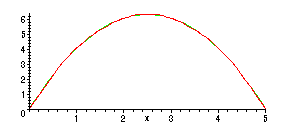
We get very close agreement already with
![]() -- the largest difference is about 0.04:
-- the largest difference is about 0.04:
> plot(f(x) - S(5,x),x=0..L);
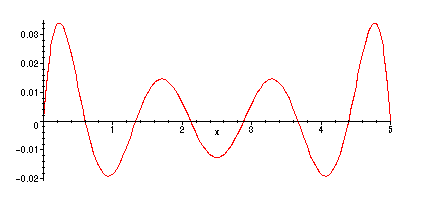
Next, we will study the corresponding solution of the heat equation obtained as
![[Maple Math]](images/FSC29.gif)
We take:
> k:=0.1;
![]()
Once again, to plot, we will need to compute partial sums of this series. Since
the exponential factors go to zero rapidly as n increases (for t > 0 ), we will
only use a few terms of the series for u (adding in more terms changes the results
very little).
> u := (x,t) -> add(b(n)*exp(-k*(n*Pi/L)^2*t)*sin(n*Pi*x/L),n=1..3);
Warning, `n` in call to `add` is not local
![[Maple Math]](images/FSC31.gif)
> plot3d(u(x,t),x=0..L,t=0..50,axes=BOXED);
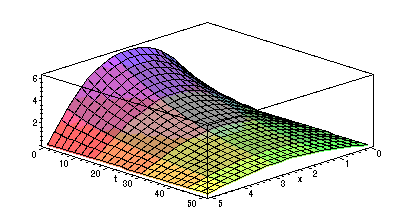
>
The slices of this plot in the planes t = const. give the temperature functions at each time.
For instance, the slice
![]() shows the initial temperature
shows the initial temperature
![]() .
.
Note that as t increases, the temperature at all points of the rod is tending toward zero.
Is this what we expect?
Next, we cosider the BVP:
![]()
![[Maple Math]](images/FSC36.gif)
![]() ,
,
![]() (ends of the wire
insulated
)
(ends of the wire
insulated
)
Here the initial temperature shows a sharp "spike of heat" concentrated
around x = 2
> f2:=x->10*exp(-100*(x-2)^2);
![]()
> plot(f2(x),x=0..L);

The eigenfunctions for the equation in the space variable
x are
![[Maple Math]](images/FSC41.gif) . So, we use
. So, we use
a Fourier cosine series for this example. (N.B. we are integrating numerically here, not symbolically)
> a2 := n -> evalf((2/L)*Int(f2(x)*cos(n*Pi*x/L),x=0..L));
![[Maple Math]](images/FSC42.gif)
> S2:=(N,x) -> a2(0)/2 + add(a2(n)*cos(n*Pi*x/L),n=1..N);
Warning, `n` in call to `add` is not local
![]()
For this function, we need more terms in the Fourier series before we start to
see good agreement with the function!
> plot({f2(x),S2(50,x)},x=0..L);
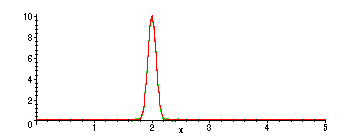
The corresponding solution of the heat equation:
> u2 := (x,t) -> a2(0)/2+add(a2(n)*exp(-k*(n*Pi/L)^2*t)*cos(n*Pi*x/L),n=1..50);
Warning, `n` in call to `add` is not local
![[Maple Math]](images/FSC45.gif)
> plot3d(u2(x,t),x=0..L,t=0..10,axes=BOXED);
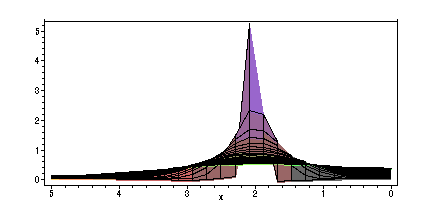
> plot(u2(x,100),x=0..L,y=0..(0.5));
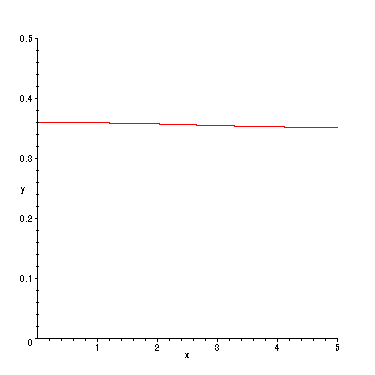
>